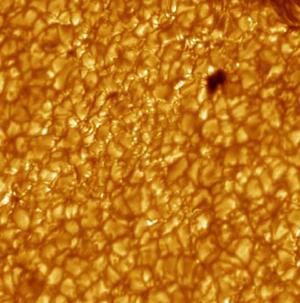Blog
Twenty Percent Off
10 May 2014
Most of the planets we have discovered around other stars have been found using the transit method. In this method, the brightness of a star is measured over time, looking for small variations in its brightness. If a planet passes in front of the star, it blocks some of the light, making the star appear slightly dimmer. If we notice a periodic dip in a star’s brightness, we can determine the presence of an orbiting planet. This is a powerful method for detecting planets, but it has two major drawbacks. The first is that it only works if the orbit of a planet crosses the star from our point of view. The second is that it only allows us to determine the size of the planet relative to the size of the star, so if we are wrong about the size of the star we are also wrong about the size of the planet.
Contrary to popular belief, we haven’t directly observed most of the exoplanets we’ve discovered. The planets are too small and dim to be imaged directly. With the transit method, the amount the star dims determines the size of the planet relative to the star. For example, if we see a star dim by 1%, we know that the planet blocked 1% of the star, so we know the planet is 1% that of the star. To determine the size of the star, we typically look at the background flicker of starlight, which allows us to determine its size. Now a new paper in Astrophysical Journal Letters finds that we may have been underestimating the size of some stars, thus their planets may be larger than we’ve thought.1
 Thomas Berger; ISP / Royal Swedish Academy of Sciences
Thomas Berger; ISP / Royal Swedish Academy of SciencesStars can fluctuate slightly in brightness due to fluctuations in their surface, such as granules seen on the Sun. The rate at which these fluctuations occur depends upon the strength of gravity at the stars surface (known as surface gravity). From this surface gravity, the size of a main sequence star can be determined. In this paper the authors compared the flicker-determined surface gravity of nearly 300 bright stars with the surface gravity derived from other methods such as temperature and metallicity. What they found was that many of the stars were actually subgiant stars rather than main sequence stars. This means they are 20% – 30% larger than expected by the flicker method. Since the size of transiting planets is determined by stellar size, their planets are 20% – 30% larger than we’ve thought.
The team also looked at dimmer stars, and found that they generally agreed with the size as determined by the flicker method. But it seems that when using the transit method we must be careful not to underestimate the size of planets around bright stars.
Bastien, Fabienne A., Keivan G. Stassun, and Joshua Pepper. “Larger Planet Radii Inferred from Stellar “Flicker” Brightness Variations of Bright Planet-host Stars.” The Astrophysical Journal Letters 788.1 (2014): L9. ↩︎